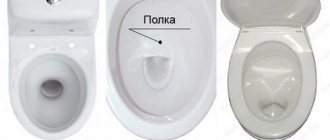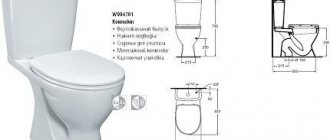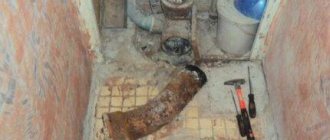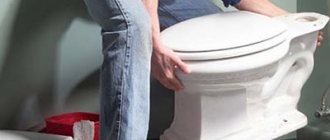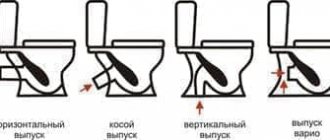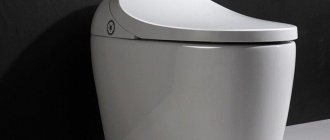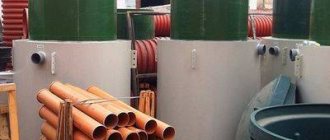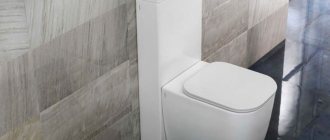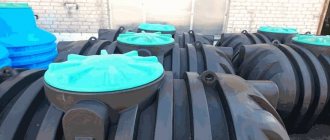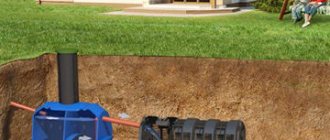In order to save space in the bathroom, many residents of modern apartments prefer to install compact models of sanitary equipment. The compact toilet is ergonomic, comfortable, and is an excellent solution for small spaces. It is a structure in the form of a bowl and a cistern attached to it. The tank, located on the shelf of the toilet seat, saves space and also reduces the consumption of additional materials for installing the structure. What models of plumbing fixtures does the manufacturer offer, how to choose the right accessory for the toilet and how to install it?
What is a compact toilet?
The concept of a “compact toilet” appeared in the country recently; the first compact toilets were a novelty. Features of this design are the low location of the flush cistern, which is installed directly on the body of the toilet. There are 2 options for plumbing fixtures:
- the shelf for the tank is made monolithically with the body of the bowl;
- a separate part is used, which is fixed into special holes, and a compact is installed on it.
The second option is used very rarely; it was used on the first models. An additional connecting collar will need to be installed. An unstable position of a tank mounted on a removable shelf often leads to damage to the mounting holes or structural failure.
Prices ↑
The pricing policy for compact toilets, like any other product, depends on the quality of the material from which it is made, the complexity and reliability of the design, unusual shape, manufacturer, and dimensions:
| Compact toilet manufacturer name | Name of the toilet compact | Parameters, cm (LxWxH) | Specifications | price, rub. |
| IFO, Russia-Sweden | Toilet compact Frisk 21030000 | 63.5x36.5x75.5 | Floor. The tank is on top of the toilet. No shelf. There is an anti-splash system. Material: porcelain. Useful drain volume is 3/6. Oblique release. Two-button flush system. Anti-dirt coating. | 6500 |
| Sanitrend, Holland | Nerea compact toilet | 74.8x35x64 | Release type – horizontal. Useful drain volume is 3/6. Hard seat included | 2520 |
| Cersanit, Poland | Compact toilet Trento TR 011 | 66x36x78 | Floor. The tank is on top of the toilet. No shelf. There is an anti-splash system. Material: faience. Useful drain volume is 3/6. Type of outlet – horizontal into the wall. Two-button flush system. Anti-dirt coating. | 3820 |
| Jika, Czech Republic | Compact toilet Vega 2451.4 | 68x36x78 | Type of release - oblique. Useful drain volume is 3/6. Microfleet seat included. | 1700 |
| Sanita luxury, Russia | Toilet compact Classic luxe | 59x34.5x40 | Floor. The tank is on top of the toilet. No shelf. Material: porcelain. Useful drain volume is 3/6. Type of release – oblique, at an angle. Two-button flush system. | 5230 |
| VitrA, Türkiye | Toilet compact S50 | 61.5x40x80 | Floor. The tank is on top of the toilet. No shelf. Material: porcelain. Useful drain volume is 3/6. Type of outlet – horizontal into the wall. Two-button flush system. Anti-splash system - yes. Duroplast seat. | 8590 |
| Serel, Germany | Compact toilet Friendly 6706 | 72.5x36x39 | Floor, corner. The tank is on top of the toilet. No shelf. Material: porcelain. Useful drain volume is 3/6. Type of outlet: vertical to the floor, horizontal to the wall. Water supply from the bottom of the tank. Two-button flush system. Anti-splash system - yes. Duroplast seat. | 12340 |
| Cezares, Italy | Compact toilet, Prati | 67x36x83 | Floor. The tank is on top of the toilet. No shelf. Material: porcelain. Useful drain volume is 3/6. Type of outlet: horizontal into the wall. Water supply from the bottom of the tank. Two-button flush system. Anti-splash system - yes. Duroplast seat. | 19880 |
You can endlessly list all the model options and their prices - there are so many of them. This, first of all, speaks to the popularity of compact toilets among modern buyers who have already understood all their real value and the comfort that such toilets provide.
Therefore, any buyer is given a fairly wide field for choosing compact toilets.
However, in order to make this choice correctly, you need to follow the recommendations of experienced specialists and make all the necessary measurements in advance not only of the toilet room, but also of the space where your toilet will be located.
If you calculate everything correctly and buy a suitable model, then you will not have any special difficulties during the self-installation process.
And during operation, you will not constantly look into the tank or under the toilet bowl to check the condition of fasteners, mechanical devices or the integrity of the bowl surface.
Any deviation from the recommendations for choosing compact toilets can lead to installation errors or undesirable consequences during their use.
Dimensions
The dimensions of plumbing fixtures are one of the important selection criteria. The useful area of toilets, especially in “Khrushchev” or panel block high-rise buildings, requires reducing the dimensions of the compact to the possible minimum. Domestic devices were produced in accordance with GOST from 1996:
General dimensions of the toilet with a monolithic shelf for attaching the tank: height 605 mm, depth – 340 mm and width – 370 mm;
Devices equipped with an additional shelf for mounting a flushing device were produced: height - 460 mm, depth 360 mm. Width 400 mm.
To arrange a children's bathroom in an apartment, you will need to purchase the smallest toilet with a cistern - up to 400 mm high.
For tall people, bowls are produced with a height of 500 mm. The optimal width size is 350 mm.
Important! When purchasing, you should keep in mind that small compact toilets with a low tank can have different shapes and seat dimensions. A family with children will need to choose a triple seat, with a separate insert for the child.
Installation methods
It is not difficult to carry out the installation yourself, but manufacturers recommend entrusting this task to a plumber. In this case, the installation will be completed correctly. Professional installation guarantees proper operation of the plumbing, proper connection and long service life of the device.
There are 2 types of fastenings:
- The open type is performed using the supplied parts, secured externally. The method is simple to implement, but not aesthetically pleasing.
- Closed ones require maximum precision and accuracy from the master; only an experienced plumber can install the toilet correctly.
In any case, before installing the device, the owners complete the finishing work in the toilet and level the area where the toilet will be installed.
Small toilets have several installation features:
- Children's bathroom fixtures are smaller in size and require less space for convenient use.
- The toilets are securely fastened, preventing them from swinging even a little.
Small structures are installed in the same way as large ones.
Advantages and disadvantages
Let us note right away that the only disadvantage of compacts is that the tank is mounted on 2 bolts and, if handled carelessly, can easily break out of the shelf or crack. But this is a controversial statement; with a normal attitude towards technology and plumbing fixtures, they will last for decades.
Among the advantages, we highlight several points:
- modern toilets will delight buyers with the price-quality ratio;
- even a person without experience will be able to install the device, following the step-by-step instructions and taking care of the fragile product;
- with the help of a compact device it is possible to save useful space;
Important! Economy class appliances will not be able to decorate the toilet; the water and sewerage pipes remain visible. But the problem can be solved by covering the space with fiberboard or plastic panels.
Bowl format from inside
Much attention should be paid to such a parameter as the internal format of the compact toilet. It may provide several options:
- funnel-shaped;
- with shelf;
- half-shelf;
- slope towards the rear wall.
The toilet must contain water coming from the water castle.
A special feature of funnel-shaped compact toilets is that the contents immediately fall into the water. Such solutions make the flushing procedure more convenient and simplify keeping the product clean. However, when using it, splashes occur, which can cause discomfort if it gets on the skin.
The version of the toilet with a shelf differs in that the contents do not immediately end up in the sewer. A mandatory requirement for ensuring high-quality flushing is the use of a significant amount of water. In some cases, you will also need to use a toilet brush. Thanks to the presence of a shelf, a person is protected from splashes.
Models with a shelf are preferable for those consumers who have pets who know how to use the toilet. Their design is different in that it can ensure their safety. A half-shelf can also provide protection from splashes, but it is distinguished by the presence of a certain bevel, which simplifies the flushing procedure.
A bowl with a shelf is one of the outdated toilet options; moreover, they are not very convenient to use, since in most cases it is not possible to achieve high-quality flushing of waste. For this reason, a person is forced to spend time removing them from the shelf of the bowl. For most, such a sight causes great hostility. But real difficulties can arise if the water is turned off or the stream that flushes away the waste is weakened.
If the choice is on a toilet with a shelf or half-shelf inside the bowl, then it is by no means necessary that the tank be equipped with a two-button flush fitting. One large flush button is enough for use.
The option with a shelf is different in that it needs to be given a lot of attention in terms of keeping it clean. They require frequent maintenance, otherwise the inner surface may become covered with plaque.
Installation
Preparing the installation site for the device. At this stage it is important to prepare a safe and level area, without uneven areas or mortar residues. Toilet bowls can be installed on wooden bases (taffeta). To do this, you need to prepare a piece of board 50 mm thick and secure it in the prepared groove.
The toilet is inserted into the semi-outlet and 2 points of attachment of the device are marked. After drilling the holes, insert dowels into them.
A rubber seal is inserted into the socket of the sewer pipe, the toilet is installed and it is tightly and neatly joined to the comb.
Important! If the tank is attached to the toilet shelf, you will need to treat the edges with silicone sealant to ensure a tight connection of the rubber coupling. All rubber parts of the tank and washers on the mounting bolts are treated in the same way.
There should be rubber washers on the mounting screws. By evenly tightening the screws, avoiding distortions, secure the toilet to the floor. There is no need to tighten the screws too much. The main thing is that the device does not swing; the rubber will still be compressed and you will need to re-tighten the fastenings.
According to the instructions, a water release system and a supply system with a float chamber are assembled, which prevents water overflow. Do not overtighten the plastic nuts; it is better to tighten the parts during a test run, achieving a tight connection, than to get a burst tank.
Fix the tank to the toilet shelf with 2 bolts, connect it to the water supply system and perform a test run of water. If a leak occurs, the connection is tightened until moisture stops escaping.
Flush type
When thinking about which toilet is better to choose, many people rightly pay attention to the type of fastening, sewer outlet and completely lose sight of the flush system installed in a particular model.
Perhaps the most famous option is direct flush . It is often called differently - cascade, horizontal , but don’t let this fool you - this is still the same widespread (since the times of the Soviet Union) flushing system, in which the water has a straight flow path and descends evenly along the wall of the bowl to the bottom drain.
Young people scold this type of flushing, and rightly so: the fact is that it has outlived its usefulness. During such a descent, the inner surfaces of the bowl remain untouched, which allows impurities and, of course, bacteria to accumulate there.
But every cloud has a silver lining - direct flushing allows the water flow to gain a pronounced intensity and purification along the flushing path is almost 100%.
The basis of a circular flush, or, as it is also called, a reverse-circular flush, is a completely different water supply system: it moves along a ring-shaped gutter and methodically washes the entire area of the thicket.
Young people really like this kind of flushing system, because with it you don’t need to use a brush for a long time - the flow of water reaches the most difficult areas of the bowl. True, in particularly difficult cases you will still have to pick up an auxiliary tool: due to the annular trajectory, the flow loses some pressure and some impurities may remain noticeable. But this already depends on the shape of the bowl, which we will talk about below.
As a rule, toilets with a circular flush system are more expensive. Recently, there has been a tendency to replace the technically outdated direct flush with a circular one.
Apparently, this is justified by time, right?
Recommendations
When purchasing a compact toilet in a store, be sure to measure the dimensions of the device and think about whether it can be installed in your bathroom. Experienced sanitary fixture installers advise paying attention to several points;
- For apartments in which the sewer pipe is connected at a certain angle, it is necessary to purchase toilets equipped with an oblique outlet. If there is sufficient distance to move the device forward, you can purchase a device with a horizontal pipe outlet.
- If the pipe comes out of the floor slab, then buy a compact only with a vertical outlet.
- Another major factor is the location of the water column in the toilet. The best option is to move the water surface forward - this will save you from splashing when flushing.
- It is not recommended to purchase devices with an installed mounting shelf. In the future, you will have to look for couplings that quickly fail.
Among domestic manufacturers, it is recommended to pay attention to the products. Among the foreign ones, in terms of price-quality ratio, we highlight compacts from the Polish ., Italian “BELBAGNO” and French devices from .
Connection to water supply
Depending on the location of the water pipes in the house, the appropriate model is selected.
There are models with side connections or models that provide for water intake from below.
The first type is preferred in cases where the shut-off valve is located above all the equipment, but if the room has a water supply at the level of the tank or below, then it is better to purchase a toilet with a bottom connection to the water supply network.
Material
What are compacts made of?
- Earthenware is the cheapest, but gets dirty relatively easily due to its rather large pores. Its undoubted advantage (as, indeed, of any ceramics) is its resistance to chemically aggressive substances. A faience toilet can be safely cleaned with solutions of acids and alkalis.
- Porcelain compares favorably with earthenware by having much smaller pores. Accordingly, it is much less polluted.
- Polymer concrete, or artificial stone, is also used for the manufacture of plumbing fixtures. Despite its beauty, the material will be a dubious choice: the high cost is combined with much lower acid resistance than earthenware or porcelain.
Polymer concrete combines an impressive appearance with fairly average consumer qualities.
If a small price difference is not a deal breaker for you, porcelain is a clear favorite.
Tank design
The location of the tank is a bowl, and it itself can be made in different configurations and have different volumes. It is recommended to install the tank where you will not rest your back on it. Otherwise, the mounting hardware will soon fail.
An important point is the location of the holes for water supply. It is best to opt for universal models , which have a side right, side left or bottom supply. It should be remembered that the service life of the fittings is 3-5 years, and the toilet is designed for 6-15 years. Thus, before the toilet loses its service life, the drain fittings must be replaced once or twice. It is advisable to prepare for this moment in advance.
Most often, about 6 liters of water are required to drain. This volume is enough to wash away any waste, regardless of its quantity. For a small drain to work effectively, 2-3 liters of water are enough . When using it, it turns out that its amount of water becomes abundant. Because of this, most owners do not often use the small drain. Among other things, a small flush can also be effective for washing the inside of a toilet tank.
To take advantage of this opportunity, it is necessary to fix a cleansing freshener that has an antibacterial effect on the inner surface. This will help you avoid the formation of plaque, as a result, your toilet will always be clean. By spending time and effort on this, you will ensure that the need for the unpleasant procedure of cleaning the toilet will not arise so often.
